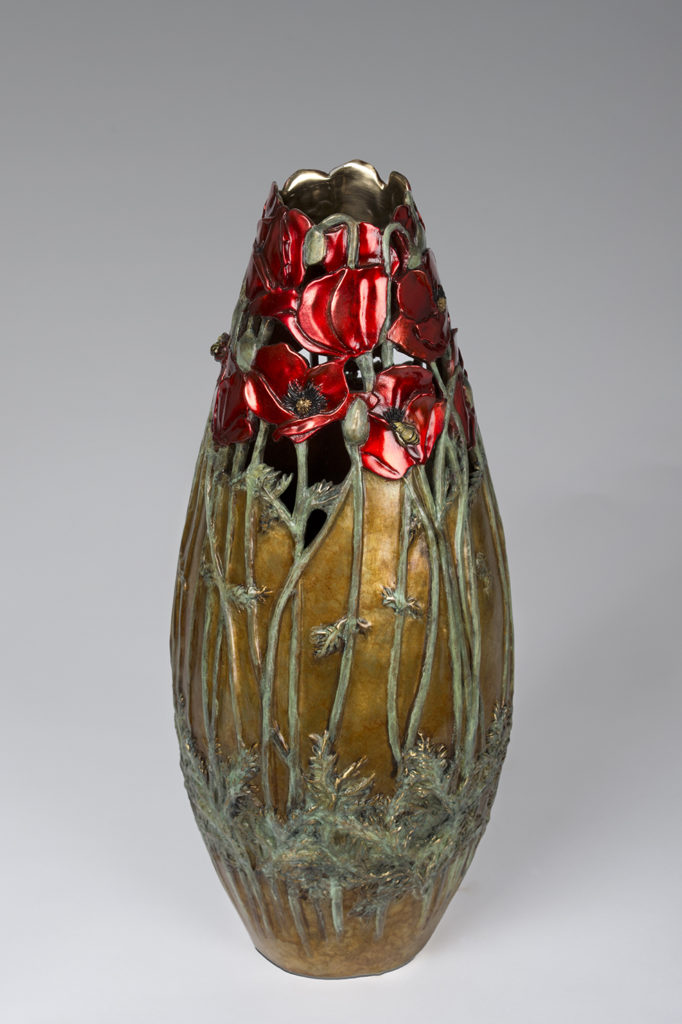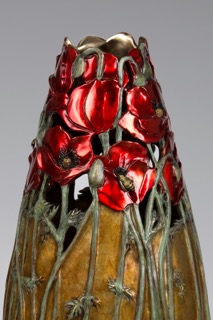Limited edition of 29
17.25″ h x 7.25″ w

Awakening Bliss :
“Bloom with the scarlet poppy – lift your nodding head,
Surrender the heavy load of your illusions – your sleepiness.
You have been dormant in waiting much too long.
Surrender all the intense suffering – in this very moment
Your soil is fertile – in need of nothing more,
You are perfectly on time for all that awaits the larger You”
Inspiration
Awakened Bliss was inspired by the common red corn poppy (Papaver rhoeas). The botanical name means sleep bearing. According to J.C. Cooper in An Illustrated Encyclopedia of Traditional Symbols, the poppy is symbolic of ignorance, sleep, indifference; and the blood red color depicts the passion of Christ. In the image of Christ on the cross, we find both death and life. In Persian literature, the red corn poppy is denoted as a flower of love – the “eternal lover” – symbolic of people who died for love. I wonder if this truly means dying to the smaller “I” rather than death of the physical form alone; allowing us to recognize the Eternal Lover? I do not know the intentions of that literature; yet I interpret it in this way.
The common poppy is also very well known for its notable ability to form a long-living seed bank that germinates whenever the soil is eventually disturbed. This was the case in the fields of Europe after WWI and the source of inspiration for the subsequent, famous writing of the Canadian physician, John McCraes’ In Flanders Fields.
The poppy buds distinctly nod downward before maturing into a bloom, with most often one bud per stem. The open bloom usually has 4 (though at times 5 or 6) petals; with simple, alternate leaves sometimes whorled; but usually lobed or pinnatifid. The blooms have many stamen which are black or bluish black – typically 16-20 in whorls. Following the spent blooms, the capsules remain erect with a fluted cap -pointed to the heavens after blooming. Stems are hairy.
Most of this I knew for many, many years, and like so many, I have always cherished seeing the charmingly beautiful, waving, delicate stems of poppies in any garden. What I gave attention to when beginning to sculpt, however, was the poppies’ habit of growthand the symbolic essence of that habit. As the poppy nods its bud downward, it appears as if in slumber. I likened this to our human tendency to do the very same – to nod our heads in sleepiness or unconsciousness – to live while being unaware of our truthful, powerful, and grandly peaceful Essence– our human tendency to live as form alone. We are born and then we grow and wait – we often get distracted and seduced with the collective world of form – nodding in slumber to the truest, awakened – blooming – states of Living. It may also be likened to living with indifference – refusing to stretch upward and SEE the entirety of our world and its infinite webof beauty – believing anyof us are actually separate from any other or anyelement of nature. When we lift our heads from utter slumber we readily recognize the world as ALWAYSkind and immensely beautifulin a manner words will always defy. We recognize we are ALL much more alike than different – for we ARE all One within the infinite web of life. We are simply here in the form of human – while so very much more than form alone could ever be.

I also more deeply appreciated the characteristic of the poppy to be capable of such a long –living seed bank – waiting often years to be disturbed enough to grow. Is that not the way with humans as well? It is often not until we are deeplydisturbed or challenged by some circumstance in our life that we are undeniably nudged (even shoved) to give our full attention to true inner growth. Not unlike the poppy, this can take many years. It may well take many lifetimes before something “disturbs the soil” or disturbs our lives, enoughto prompt the poppy, and us, to fully bloom. And once the bloom is spent (our human lives here on earth in this season end), it is then the poppy (and we) remain erect; pointing toward the heavens as our seeds scatter into our world – nourishing new growth and blooming all around it – the Wind (symbolic of Spirit) sprinkling the seeds for miles upon miles. We ARE each indeed a vital part of an infinite web of Life.
The poppy is sometimes known as a weed, since it flourishes as a weed in grain fields; and it has many characteristics of a hardy weed. I love it is referred to as a weed – because most weeds simply refuse to stop growing. How lovely if we were able to follow that tenacious lead? I’ve always loved dandelions for this very reason – they simply refuse to stop growing. That “eternal lover” the Persian poets refer to is ever patient – always, patiently in wait, for our awakening to our true Essence.
The delicate poppy stems remind me of the flexibility we benefit from always remembering to hold in our lives. Being flexible also means being tolerant – we do not expect the nodding poppy bud to hold glorious scarlet blooms while it is still nodding in sleep. With time, it WILL become upright and bloom– and this may take many years (or lifetimes). I believe we do well to remember the poppy habits as yet another example of how nature offers us such a beautiful compass for our lives. This habit of the poppy also reminds us that we cannot expect others to behave in ways they are not yet aware may be detrimental to themselves and/or others –if they are unconscious beings (nodding poppies in waiting) we cannot expect them to behave consciously if they, in fact, remain unconscious. They are still, for whatever reason, in slumber (some more deeply so than others); while yet a vital essence of the whole of life. Christian teachings invite us to, “Forgive them, for they know not what they do.” Each of us hold our own unique challenges – each of us carry a past laden with events and experiences that uniquely color who we are in the present – each of us will slumber only until we are nudged in the perfect season for us to finally begin to grow upright and ultimately bloom our glorious innate beauty. Having well known the depths of slumber ourselves, we can find grace, patience and compassion to patiently await the other to awaken, and recognizethe sheer beauty of the entire garden of Life. We ultimately cannot force the bloom of any flower – nor that of any human being. We await its season with hope, and with Loving acceptance, as we hold that promise of Spring to always arrive at its perfect time– for both others and ourselves. We each awaken most often slowly and gradually – yet always in our own perfect timing. And some awaken and bloom quite suddenly – mirroring again the habit of poppy. Each spring nature reminds us of this beautiful promise – new life indeed will always come.
vessel – the powerful number of three, that grand triad of Mother, Father, Child – Father, Son, Holy Spirit – beginning, middle, end – the Buddhist three precious jewels, etc. The number three was used here, symbolic of birth, life, and death. Our honeybees continue to be on a dramatically alarming decline. They are responsible for pollinating more than one-third of all the fruits, nuts, and vegetables we eat daily. Their hive communities are a lovely blueprint for living in utter community and immense generosity. These extraordinarily intelligent insects are enormousblessings to the balance of our ecosystem and yet many of us continue to blatantly neglect their care. Some have written the beehive as symbolic of the church and the honeybee as the messenger between heaven and earth. If this is true, we are certainly failing to heed the blatant call of these sacred messengers.
The three honey bees on the vessel were sculpted using actual wax from a honeycomb on one of the hives from the small farm where I was raised in PA/USA – they are present as our visible reminder of their beautifully awakened, generous presence– and as another invitation for us to more deeply care for them through our daily habits. I used wax from these hives to sculpt them, and to remind myself that even though I often may feel my own life insignificant – every life– in any form IS always grandly significant regardless of its unique color – always a vital contribution to the garden of life.
Awakened Bliss is offered in a limited edition size of 29 (the number of poppies on the vessel). It is hoped to inspire a nudging for each who pause in her presence, to lift their heads and hearts high – open themselves to continual inner growth in all ways. It is hoped to impart an essence of the deep bliss of conscious living – the awakened bliss of Love. It is hoped to remind us of that state in which we quite naturally are pointedly and sensitively aware of our entire universe and where the life of even one single honeybee both matters and affects the entire web of life – it is honored – it is warmly and tenderly cherished.
We humans are not intended to remainnodding in bud forever – we are intended to awaken to the utter knowing that there is no “world out there” – we ARE each one vital slice of the world. Each of us, in all our wildly diverse forms of life, areone tiny, while vital, slice of the entire universe. We are intended – as we live on this earth as humans – to awaken to our true Essenceand bloom in glorious, word defying, Awakening Bliss.
C. Alleman ©2019
www.plants.usda.gov/plantguide/pdf/cs_oebi.pdf
www.luontoportti.com/suomi/en/kukkakasvit/evening-primrose
www.riwps.org/eveningprimrose.htm
http://bugguide.net/node/view/38844
www.altnature.com/gallery/Evening_Primrose.htm
*www.nsf.gov/news/news_summ.jsp?cntn_id+125636
The Secrets of Wildflowers, by Jack Sanders 2003
